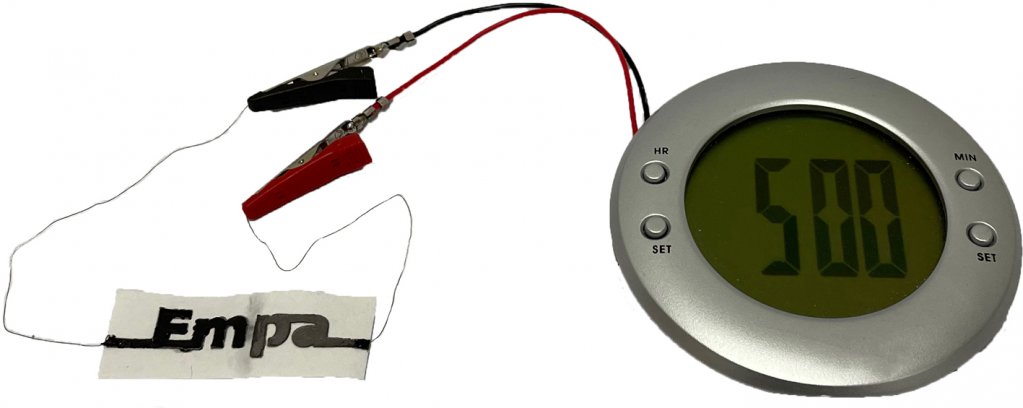-300x192-cropped.jpg)
Restoring drinking water supply in downtown Amsterdam
Salts within the paper dissolve and charged ions are released making the electrolyte ionically conductive.

29th July 2022
Innovation in Textiles
|
Switzerland
A water-activated disposable paper battery developed at Empa in Switzerland could be used to power a wide range of low-power, single-use disposable electronics, such as smart labels for tracking objects, environmental sensors and medical diagnostic devices.
The battery, devised by Gustav Nyström and his team, is made of at least one cell measuring a square centimetre and consisting of three inks printed onto a rectangular strip of paper. Sodium chloride or table salt is dispersed throughout the strip of paper and one of its shorter ends has been dipped in wax.
An ink containing graphite flakes, which acts as the cathode, is printed onto one of the flat sides of the paper while an ink containing zinc powder, which acts as the anode, is printed onto the reverse. Another ink containing graphite flakes and carbon black is printed on both sides of the paper, on top of the other two inks. This makes up the current collectors, connecting the positive and negative ends of the battery to two wires, which are located at the wax-dipped end of the paper.
When a small amount of water is added, the salts within the paper dissolve and charged ions are released making the electrolyte ionically conductive. The ions activate the battery by dispersing through the paper, resulting in zinc in the ink at the anode being oxidized and releasing electrons. By closing the external circuit the electrons can then be transferred from the zinc-containing anode to the graphite cathode where they are transferred to and reduce oxygen from ambient air. These redox reactions (reduction and oxidation) generate an electrical current that can be used to power an external electrical device.
LCD
To demonstrate the ability of their battery to run low-power electronics, Nyström’s team combined two cells into one battery to increase the operating voltage and used it to power an alarm clock with a liquid crystal display (LCD). Analysis of the performance of a one-cell battery revealed that after two drops of water were added, the battery activated within 20 seconds and when not connected to an energy-consuming device, reached a stable voltage of 1.2 volts. The voltage of a standard AA alkaline battery is 1.5 volts.
After one hour, the one-cell battery’s performance decreased significantly due to the paper drying. However, after the researchers added two extra drops of water, the battery maintained a stable operating voltage of 0.5 volts for more than an additional hour.
The researchers believe the biodegradability of paper and zinc could enable their battery to minimise the environmental impact of disposable, low-power electronics.
“What’s special about our new battery is that, in contrast to many batteries using a metal foil that is gradually consumed as the battery is depleted, our design allows only the amount of zinc that is actually needed to be added the ink for the specific application,” says Nyström. “Metal foils are more difficult to control and not always fully consumed leading to a waste of materials, so the more zinc the ink contains, the longer the battery is able to operate.
“A more critical point of the battery’s current design with water activation is the time it takes for the battery to dry out but I’m sure this can be engineered differently to get around this problem. For environmental sensing applications at a certain humidity or in wet environments, the drying of the paper would not be an issue.”
Supercapacitor
Previously, Nyström’s team developed a paper-based degradable supercapacitor that could be charged and discharged thousands of times without losing efficiency. Compared to batteries of the same weight, supercapacitors have an energy density that is around 10 times lower – while at the same time having a power density that is around ten to one hundred times greater. Supercapacitors can therefore be charged and discharged much faster and can also withstand many more charge and discharge cycles.
“The two devices are actually complementary”, said Nyström. “The idea behind the new water-activated battery was to be able to manufacture devices that are fully charged and that only release this energy after the triggering of a stimulus – in this case simply a drop of water.”

Business intelligence for the fibre, textiles and apparel industries: technologies, innovations, markets, investments, trade policy, sourcing, strategy...
Find out more